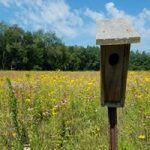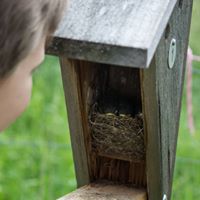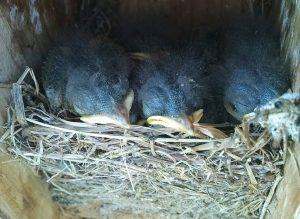Spring is in the air and cavity nesting birds are looking for a rent free location from March through August to raise a feathered family. Are you interested in becoming a successful tiny house landlord? If so, there are a few simple things to consider before opening your rental to the public.
Cavity nes ting birds, including Eastern Bluebirds, Tree Swallows, House Wrens and Chickadees, are in need of nest boxes due to a loss of habitat by development. As land has become more populated, the trees that often housed nesting birds in their natural cavities have decreased. There is also a supply issue with cavity nesting birds competing with aggressive House Sparrows and Starlings for nesting space. Given the right location and commitment to monitoring, nest boxes can have an immediate and positive impact on increasing the population of cavity nesting birds.
ting birds, including Eastern Bluebirds, Tree Swallows, House Wrens and Chickadees, are in need of nest boxes due to a loss of habitat by development. As land has become more populated, the trees that often housed nesting birds in their natural cavities have decreased. There is also a supply issue with cavity nesting birds competing with aggressive House Sparrows and Starlings for nesting space. Given the right location and commitment to monitoring, nest boxes can have an immediate and positive impact on increasing the population of cavity nesting birds.
Nest box placement is one key component for success. Cavity nesting birds are attracted to gras sy open areas or yards. They prefer to have a place to perch near the nest box which can be a tree branch, a fence post or even a garden stake. If possible, attaching the nest box to a single metal pole in the open helps to deter predation from animals such as raccoons. The entrance hole of the nest box should open to the East, since this will help protect the box from inclement weather during the spring and summer months.
sy open areas or yards. They prefer to have a place to perch near the nest box which can be a tree branch, a fence post or even a garden stake. If possible, attaching the nest box to a single metal pole in the open helps to deter predation from animals such as raccoons. The entrance hole of the nest box should open to the East, since this will help protect the box from inclement weather during the spring and summer months.
Another key component to nest box success is monitoring of the nest box during nesting season. It has been scientifically proven that nests that are monitored on a weekly basis have better success rates than those that are only installed and never visited again. Boxes that are not monitored often become a haven for invasive species of birds like House Sparrows and Starlings. Monitoring is as easy as taking a look to identify what species of bird is building a nest in the nest box, keeping track of when and how many eggs are found in the nest, identifying when the eggs have hatched and verifying when the birds mature and fledge from the nest. More specific information about nest identification, species information and the monitoring process can be found at https://nestwatch.org/.
If you are interested in building a nest box and exploring the world of cavity nesting birds, please join Bill Stovall of Delton, MI who has been making bird houses for more than 25 years, in constructing a nest box to take home and learning about the species of birds who use them and need them. Learn how you can become a citizen scientist and contribute data to the NestWatch website where researchers use the information c ontributed to monitor the condition of breeding bird populations.
ontributed to monitor the condition of breeding bird populations.
Cost: $15 per nest box kit
Members: Adults = $5, Senior or student = $4, Children (2-17) = $3 Non-member: Adults = $7, Senior or student = $6, Children (2-17) = $5
Pre-registration required by April 9, 2018 https://events.anr.msu.edu/BuildaBox2018/

A legacy of conservation; a commitment to sustainability.
Kellogg Bird Sanctuary12685 East C Avenue
Augusta, MI 49012
Phone: (269) 671-2510 birdsanctuary@kbs.msu.edu